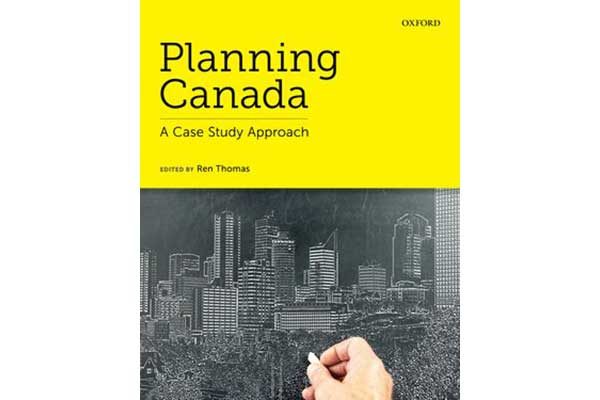
Editor: Ren Thomas (Oxford University Press, 2016)
One of the easiest ways to learn something is by seeing how it was done before, somewhere else, with a similar context. We can understand abstract concepts, learn these items through theory, but whenever possible, seeing a practical application will help propel our understanding beyond what theory alone can teach us. Over 6 pages of authors have contributed to Planning Canada: A Case Study Approach, all learned individuals from different parts of the country speaking to specific case studies—real-life examples of planning exercises implemented in their own communities and across Canada. This is key as well because many of the resources available to planning students in Canada come from other countries, most consistently the US, which works, but limits certain aspects since the rules, regulations, and procedures specific to our nation are not the same as others outside our borders.
The book is broken out into nine sections, each highlighting a different aspect of planning: Community Development and Social Planning, Urban Form and Public Health, Natural Resource Management, Housing, Participatory Processes, Urban Design, Urban Redevelopment, and Transportation and Infrastructure. Reading the headings alone, it is easy to be intrigued and excited about what is to come in the rest of the book.
As someone who has always been extremely interested in the planning world, I was overwhelmed with the depth of information Planning Canada contained, in such easy, digestible form. Within the introduction of the book, titled Fundamentals of Planning, editor Ren Thomas talks to why planning is significant and why case studies are important, then quickly jumping into a brief history of planning in Canada. A thoroughly enjoyable read, beginning in 1867 with confederation and industrialization, the book does an excellent job of breaking down how Canada grew through the eyes of the planning community, and how planners grew as a profession alongside our country. It is filled with amazing bits of anecdotal information, such as: “…Frederick Law Olmsted brought his social concerns and democratic ideals to Caanda. Olmsted oversaw the design of Mount Royal in Montreal (1876). Calvert Vaux, Olmsted’s co-designer on Central Park, designed Rockwood Park in Saint John.”
The introduction continues with how “Urban development slowed during an economic lull preceding World War I, and population growth in cities slowed during the wartime years.” This leads into the beginning of master planned communities in Canada, and Thomas highlights the major points in world history and how this affected planners as a profession. It ends with the challenges currently facing planners in Canadian cities and regions: issues we are very accustomed to hearing about currently, such as reversing car dependance, failing infrastructure, climate change, and income and wage gaps.
To speak of each chapter individually would be monumental for any review, and would not be useful for a potential reader. Instead, I think it is important to highlight some of the key cases studied in the book, to give the reader a feel of what to expect. For instance, in the first chapter—Community Development and Social Planning—we learn about the melting pot that is Canada and how different jurisdictions and planners work to make sure that this mix of cultures feels respected and acknowledged in Canada. The first case study comes out of Richmond, BC and talks to some of the “challenges and solutions in developing municipal social policies in a fast-changing multicultural municipality facing multiple social issues, such as housing affordability, childcare, immigrant integration, opportunities for public engagement , and planning for an aging population.” It also focuses on the methods undertaken to understand the problems pointed out, how they could start to approach them and how, in the end, it was concluded in a final report that “The City cannot do it alone” and needs to build relationships with “senior government”. This is the method that carries throughout, with subjects such as “Building up While Sprawling Out? Paradoxes of Urban Intensification in Ottawa,” “Climate Adaptation Planning in British Columbia,” “Energy-Efficiency Retrofits and Planning Solutions for Sustainable Social Housing in Canada,” and “Urban Regeneration in a Mid-Sized City.”
It goes without saying that, the planning case studies chosen from across the country have been carefully curated for the highest impact and educational value, as well as relevance to today’s pressing issues. This is why the book is as successful as it is. Instead of teaching the student or researcher about the basics of climate adaptation, we are shown how, for example, “The Elkford experience revealed how planners can work to help the public better understand a complex issue and the inherent risk embedded within it. These cross-disciplinary collaborations will be imperative as climatic impacts intensify.” Throughout, one can see the exact methodology that is used and learn the theory….but learn it by seeing it put in action, instead of just hearing about how it could work.
Planning Canada: A Case Study Approach should be required reading for any planning course taught in Canada. The systematic breakdown of all the pressing issues for planners today, the accessible nature of the book’s structure, and the practical knowledge that is shared throughout make it invaluable. As someone tangentially related to the planning community, I learned vast amounts from this book, and know that I will continue to refer back to it at moments when I may need information for a project or article. This being the case, Ren Thomas has done an excellent job in drawing together all the collaborators and studies included into a single compendium, which anyone from a concerned citizen to a city mayor could read.
***
The official book launch for Planning Canada: A Case Study Approach, will be happening on Friday, June 17th, 4:00pm-5:30pm at the UBC Bookstore at the University of British Columbia in Vancouver. For more information, click here.
**
To learn more about Planning Canada: A Case Study Approach, visit the Oxford University Press website.
*
Jeremy Senko is happily lost in the world of theoretical architecture and design. He is forever a student at heart, consistently reading, experiencing and learning about the world he inhabits. More specifically, he works as an Interior Designer in Vancouver and plays an active part in bettering the environments we live in.





One comment
This book is currently on order at the Toronto Public Library.
Check our website:
http://www.tpl.ca for Planning Canada and other books in our urban planning collection at the Toronto Reference Library, Humanities and Social Sciences Department, 2nd floor.